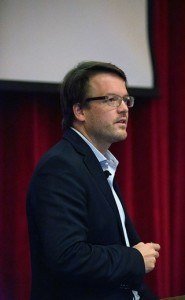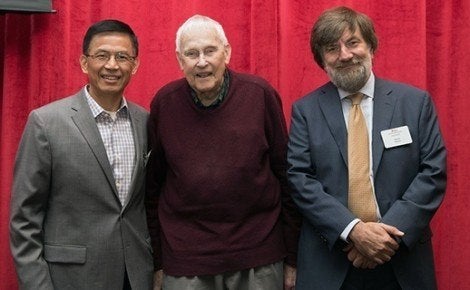October 29, 2015 — Cutting-edge work on molecular mechanisms involved in the cellular response to stress was the focus at the 18th annual John B. Little Symposium, held October 23-24, 2015 at Harvard T.H. Chan School of Public Health.
The symposium is hosted each year by the John B. Little (JBL) Center for Radiation Sciences. Both the symposium and the center are named for John B. Little, James Steven Simmons Professor of Radiobiology Emeritus, one of the first scholars to characterize problems in public health associated with radiation exposure.
Attendees packed the School’s Snyder auditorium to hear experts in the field discuss topics related to oxidative stress, which is caused by high levels of chemically reactive molecules containing oxygen (called reactive oxygen species, or ROS). Oxidative stress can cause damage to DNA, protein, and lipids, leading to myriad pathologies such as type 2 diabetes, Alzheimer’s disease, atherosclerosis, and cancer. Some speakers focused on mitochondria, the cell components that convert food and oxygen into energy and power metabolic activities. Mitochondria also generate ROS, and may overproduce it if their function is deregulated.
Work in this area provides important evidence toward advancing the JBL Center’s research mission in radiation sciences, said Director Zhi-Min Yuan, professor of radiobiology. One of the ways that oxidative stress is induced is through ionizing radiation from environmental sources or medical procedures such as CT scans. Elucidating this process will help researchers understand mechanisms underlying the cellular response to ionizing radiation and how the biological system adapts, he said.

In his opening remarks, Acting Dean David Hunter observed that some attendees may be wondering why this event was being held at a school of public health. A quarter of the School’s faculty identifies as laboratory scientists, Hunter said, and the School has “a deep commitment to analyzing problems from the cell level to the community level.”
Hunter and other speakers acknowledged the support that the Morningside Foundation, established by the family of the late T. H. Chan, has provided to the JBL Center and the symposium. The foundation also supported the establishment in 2012 of the Morningside Professorship in Radiobiology, in honor of Little. Gerald Chan, SM ’75, SD ’79, director of the foundation, was a student of Little’s.
Presenting during the symposium’s opening session, Tobias Walther, professor of genetics and complex diseases, discussed new advances in understanding the complex biology of lipid droplets—organelles that store energy for cells and interact with mitochondria. Walther’s research partner Robert Farese, professor of genetics and complex diseases, moderated the session, which also included Amy Wagers of Harvard Medical School. She described her lab’s work identifying a protein that seems to reverse age-related muscle mass decline in mice. Read more about Walther and Farese’s work.
Harvard Chan School faculty members Bernardo Lemos, assistant professor of environmental epigenetics, and James Mitchell, associate professor of genetics and complex diseases, also led sessions.
Photos: Emily Cuccarese
